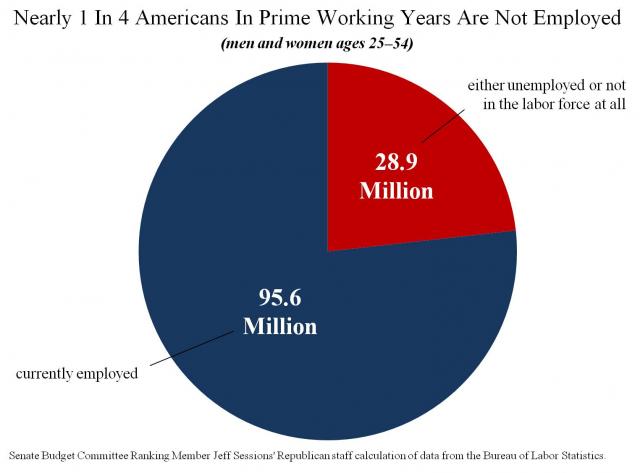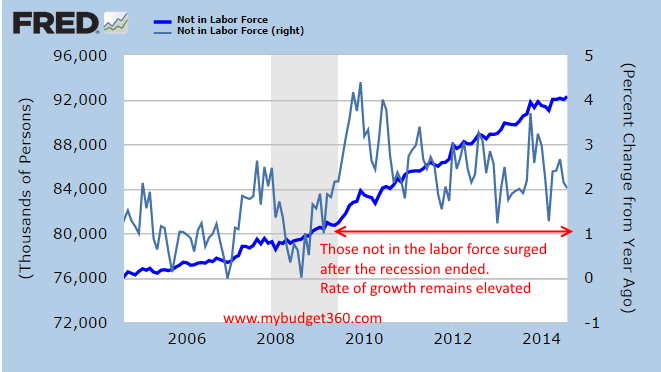Primed for work but out of a job: 1 out of 4 Americans 25-54 not working and the continued expansion of those not in the labor force.
- 1 Comment
For most Americans, the best indicator of a healthy economy is having a job. With many Americans entering older age, the number of those not in the labor force is booming. It doesn’t appear to be on the radar of people that the reason the unemployment numbers look the way they do is because a massive number of Americans simply are not counted in the labor force. This ability to ignore a large portion of your population allows the numbers to appear better than they are. But this is for the entire US population. If we look at those 25-54 we find that 1 out of 4 is without a job. This is the prime working years for many Americans. The Great Recession has been a challenge for many working families. The lack of good paying work, weaker benefits, and inflation has dug deep into the pockets of many Americans. When 1 out of 4 Americans in their prime working years is out of work, something else has to give.
25-54 and 25% out of work
A Senate Budget Committee report shows an inordinately large number of Americans in their prime working years out of work. The problem for many Americans is the inability to find good jobs (or any jobs) in the current economy. We have skills being mismatched but also, many companies have found it better to provide low wage work and simply filter profits up to the top. This is a reason why the stock market is doing so well while most families are not.
The chart is sobering to look at:
The argument that this entire jump has come from older age Americans is simply not true. Yes, a big push has come from demographic changes but this doesn’t fully address why so many prime aged working Americans are without a job:
“(Weekly Standard) Those attempting to minimize the startling figures about America’s vanishing workforce—workplace participation overall is near a four-decade low—will say an aging population is to blame. But in fact, while the workforce overall has shrunk nearly 10 million since 2009, the cohort of workers in the labor force ages 55 to 64 has actually increased over that same period, with many delaying retirement due to poor economic conditions.
“In fact, over two-thirds of all labor force dropouts since that time have been under the age of 55. These statistics illustrate that the problems in the American economy are deep, profound, and pervasive, afflicting the sector of the labor force that should be among the most productive.”
Part of this is coming from the trend of creating a very large low wage labor force in America. The recession destroyed many good paying jobs and replaced them with many lower wage jobs. Given that inflation is happening (just look at the price of food, housing, cars, college, etc) and you will realize that having less income is not healthy when most costs of goods are going up.
The non-labor force in the United States is massive:
“You’ll notice over this 10 year period, those not in the labor force increased by 16 million. What is even more telling is that 12 million of that growth came in the last 5 years alone (a time of economic recovery on paper). But the recovery in many respects has come from firms cutting wages, slashing benefits, and suffocating the middle class. This has done wonders with increasing profits for Wall Street but 90 percent of stock wealth is controlled by 10 percent of the population.â€
92 million Americans are counted as not part of the labor force. And it is important to note the rate of growth only in the last five years alone. Older Americans certainly have a part here but there are other forces at work as well. The 25-54 chart above highlights some deeper structural changes. Unfortunately very little attention has been given to the US middle class in a generation. Ignore something and it will rarely get better. I think this is the problem that we are facing. Having a high number of your prime aged workers out of work can’t be seen as a positive.
If you enjoyed this post click here to subscribe to a complete feed and stay up to date with today’s challenging market!1 Comments on this post
Trackbacks
-
laura m. said:
This should solve the problem, it has for relatives, myself and hubby and some friends back during the 80’s recession. Relocate! we and others moved into another state, several went overseas and worked for gov contractors. People today can go online, then get off their haunches and find work. If my generation could train for skilled labor, with no computers or smart phones then to help us out, or college degrees, then today’s slackers surely can if they have the “want to” motivation.
September 29th, 2014 at 7:59 am


 If you enjoyed this post click here to subscribe to a complete feed and stay up to date with today’s challenging market!
If you enjoyed this post click here to subscribe to a complete feed and stay up to date with today’s challenging market!